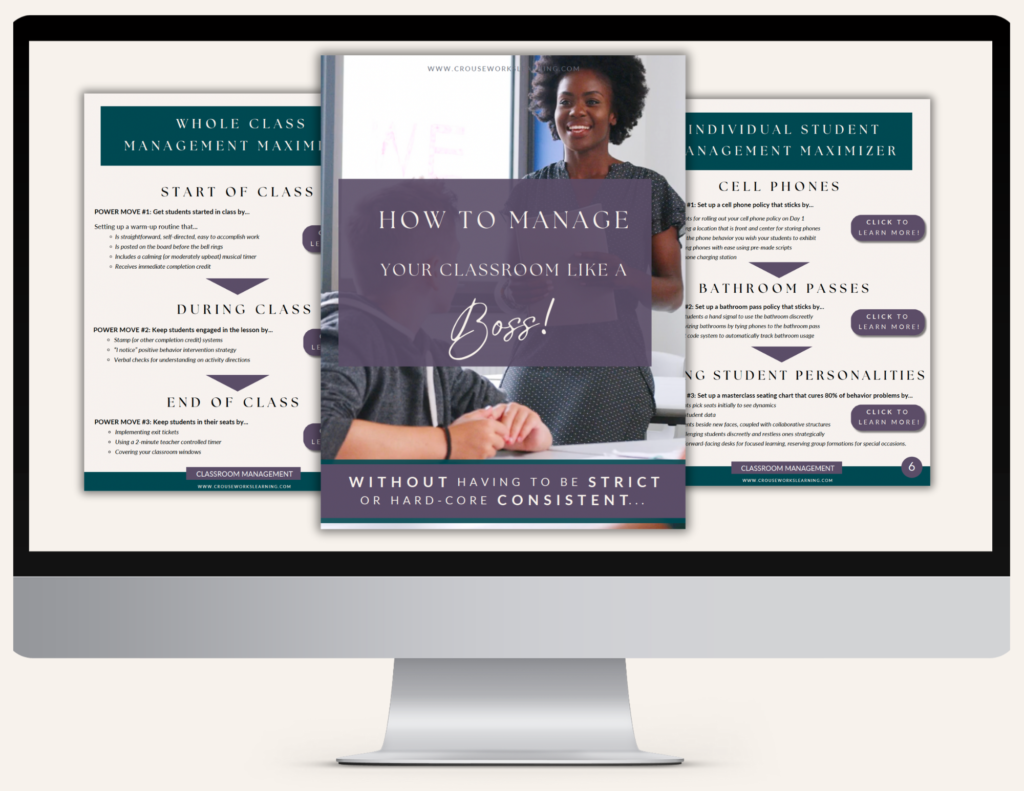If a first-year teacher asked you for your one piece of advice for setting up an effective classroom environment? What would you say? What would you consider to be the linchpin for setting your students up for success in the classroom?
For me… that’s an easy one.
And it deals with the first 5 minutes of class.

Because, you see, I have a theory. And the theory goes- if you can help a student find success within the first 5 minutes of class, they’ll be more open to your lesson afterward.
So, what does that look like exactly? Well, if you have never considered giving students a warm-up during the first 5 minutes of class, I implore you to consider it.
Using warm-ups as an academic and behavior management strategy is a game changer for any classroom!
Now, a little disclaimer here: not just any type of warm-up will work for this.
You need to have a warm-up that has 3 critical features…. Are you ready to take notes?
Okay, here we go!
FEATURE #1: Your warm-up must be straightforward, self-directed, and easy to accomplish
Ever walk into a staff meeting, and the first thing they want you to do is pontificate over the meaning of teaching (after you’ve just had a very long day in the classroom)!? Yeah, it’s happened to me more than a couple of times. And in those moments, it’s not that I “can’t” answer those questions… it’s just that… it’s going to take a lot, and I mean a lotttttt of mental energy that I just don’t have…. So, what do I do? Politely pretend to be busy with my work email.
Now, I hate to say it, but students feel the exact same way about our classes.
Picture this: Students roam around the hallways throughout the day, going to about 7 different classes (all of which are subjects they believe they could more or less do without in their lives). And in those classes, students are poked, pushed, and prodded to write, analyze, and graph things… And then they walk into your class, and the first thing they see on the board is a warm-up question that is so contextually confusing, so academically overwhelming, so highly conceptual and esoteric… that what do they decide to do? Talk to their friends, of course! Get on their phones. Go sharpen their pencils. Anything but have to put their minds on the warm-up.
So, with that being said, the first guiding principle I follow when making warm-ups is that they must be straightforward, self-directed, and easy to accomplish within minutes.
The warm-up must be simple enough that students can complete it independently with little support.
Because remember, the goal of the warm-up is not just academic gains but also motivational and behavioral gains.
You see, the mistake I often see teachers make is that they use their warm-up questions solely for academic purposes rather than motivational purposes. Yes, warm-ups absolutely move the needle for students regarding review, reteach, and pre-teach strategies. But, it is so important that whatever question you choose to give your students for your warm-up, that ALL students in the classroom will have success with it and, therefore, feel more motivated going into the upcoming lesson.
Here are some examples of effective and ineffective warm-ups…
EXAMPLE 1: Use your warm-up to review yesterday's lesson
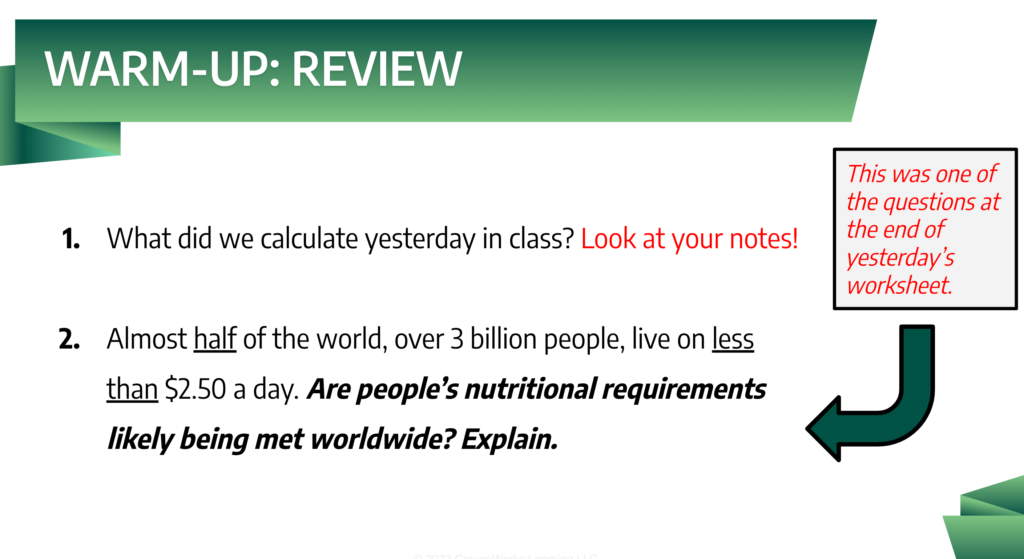
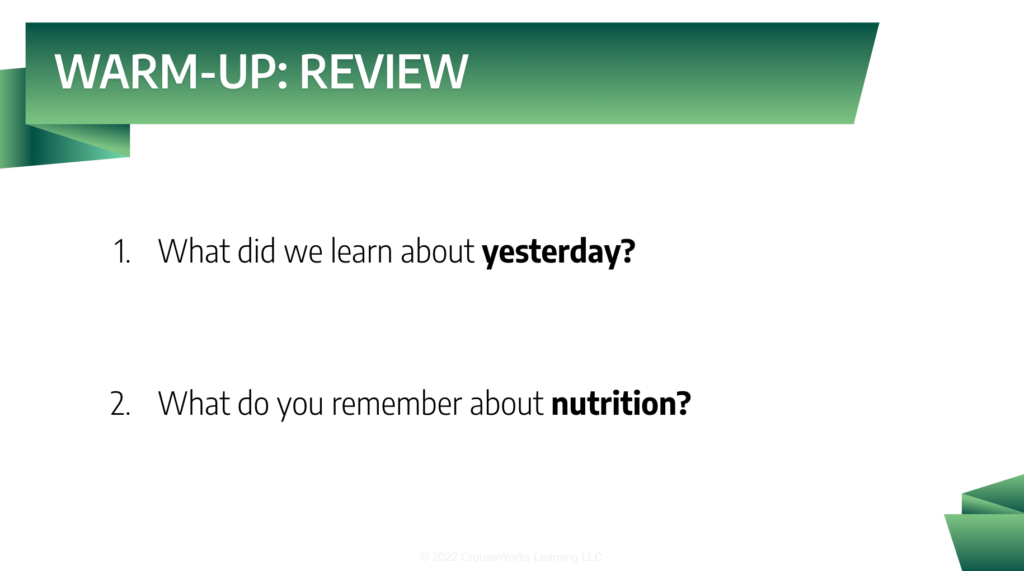
EFFECTIVE WARM-UP:
- Students are explicitly told which resources they can reference for support
- Does not require a significant cognitive lift because answers come directly from students’ previous work
- OUTCOME: Students will generate specific answers, have more to contribute to a class discussion, and will get a sufficient review of yesterday’s lesson without significant cognitive strain.
INEFFECTIVE WARM-UP:
- Students must recall yesterday’s lesson off the top of their heads
- Requires a more significant cognitive lift because students will likely try to pull answers out of thin air (rather than getting out their notes)
- OUTCOME: Students will likely write “I don’t remember” or give you generic answers that don’t lead to much of a classroom discussion.
EXAMPLE 2: Use your warm-up to review yesterday's quiz

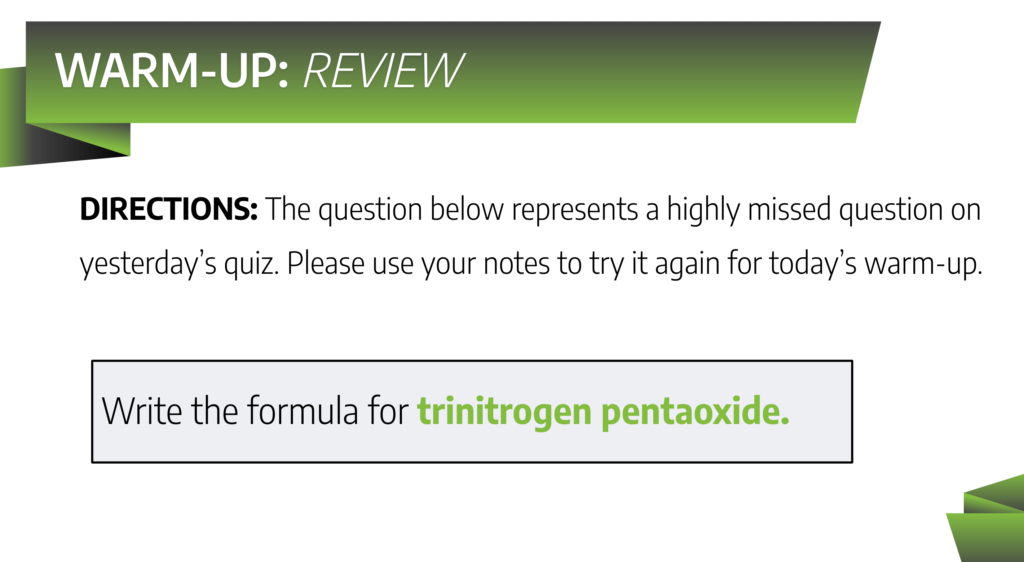
EFFECTIVE WARM-UP:
- The error in the example is not tied to a specific student but rather represents a general error that most students made
- Students are motivated to complete the warm-up because they love finding “mistakes” in things
- Mistake conversation is framed positively as finding the teacher’s ” Favorite Mistake” on yesterday’s quiz
- OUTCOME: More students complete the warm-up and will participate in a class discussion because they can point out specific observations they see.
INEFFECTIVE WARM-UP:
- Since many students missed this question on yesterday’s quiz, they will likely not do much better a second time without more supports
- OUTCOME: Students will likely write the same answer they wrote on the quiz.
EXAMPLE 3: Use your warm-up to ask an opinion question
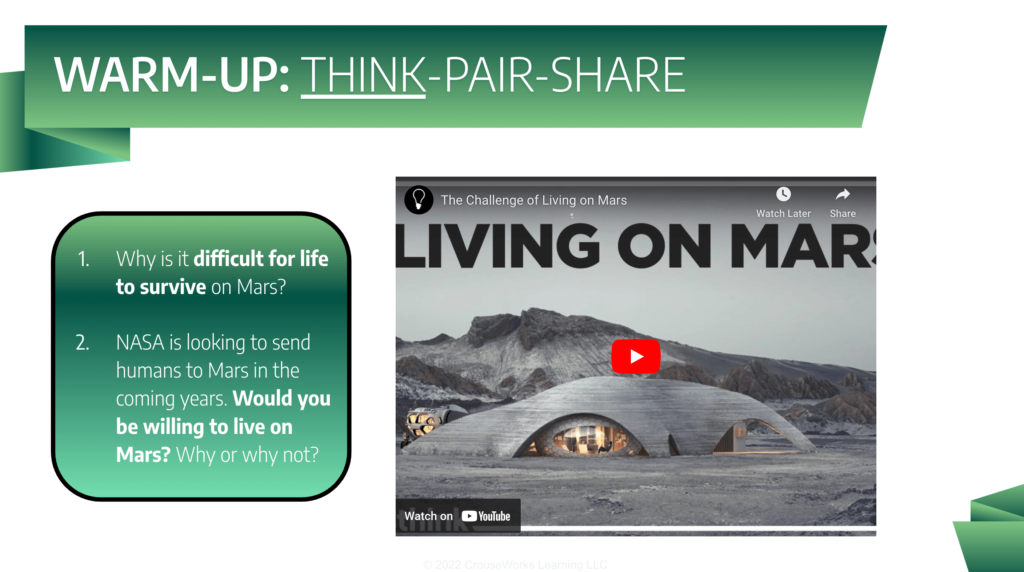
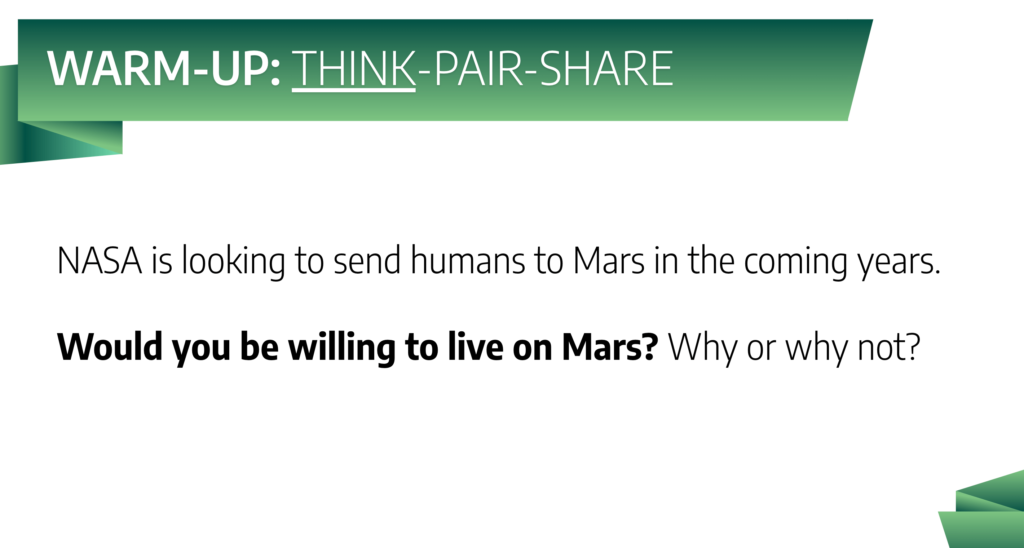
EFFECTIVE WARM-UP:
- Students watch the video first to see why living on Mars is difficult. Through this video, they are introduced to general ideas and vocab.
- Students can use the ideas and vocab they wrote down from Question 1 to create more specificity in their answer for Question 2
- OUTCOME: Students will be more engaged in the lesson because they can better visualize the obstacles. A more robust classroom discussion will take place because students have more detailed answers.
INEFFECTIVE WARM-UP:
- Many students have limited background knowledge about Mars and will struggle to formulate ideas off the top of their heads
- This warm-up takes significantly more cognitive load because students have to have to pull ideas out of thin air
- OUTCOME: Students will create simple and generic responses that are likely not tied to any scientific reasoning
EXAMPLE 4: Ask students an inquiry question about the upcoming lesson
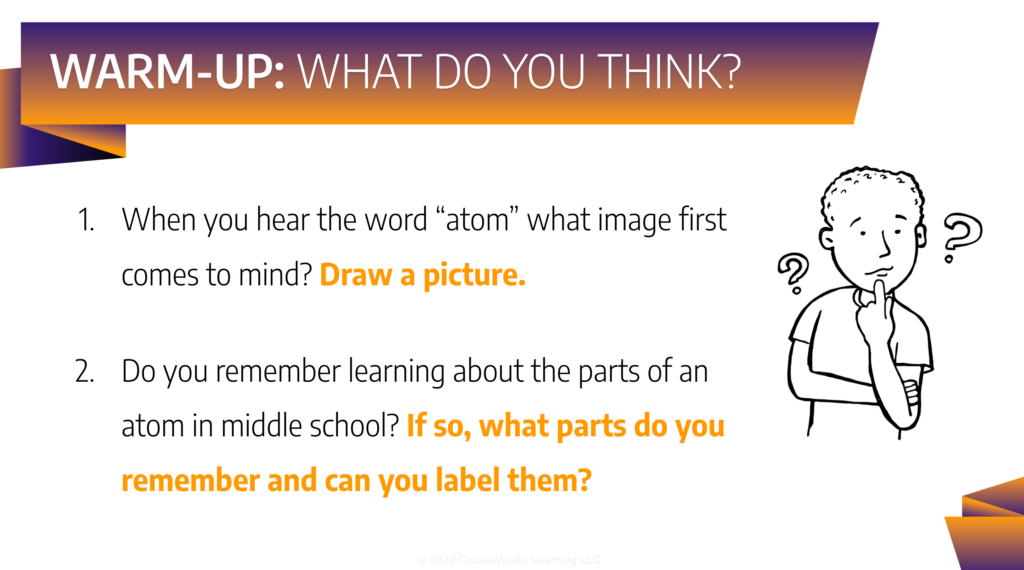
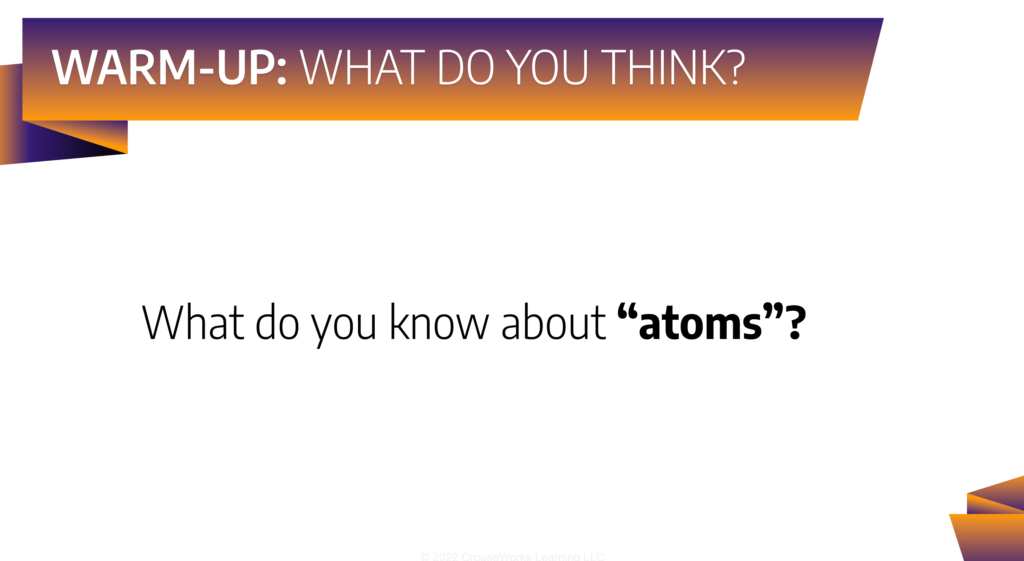
EFFECTIVE WARM-UP:
- Students are prompted to draw out their ideas first (an easy and low-risk way to brainstorm)
- Students are directed back to a time (e.g., middle school) when they might have had some experience with “atoms”
- OUTCOME: Students will surprise themselves by remembering more about atoms than they thought. They will likely draw an atom (similar to Jimmy Neutron’s atom) and label the protons, nucleus, and electrons.
INEFFECTIVE WARM-UP:
- Many students have limited background knowledge about atoms and will struggle to formulate ideas off the top of their heads
- This warm-up takes significantly more cognitive load because students have to have to pull ideas out of thin air
- OUTCOME: Students will likely write “I don’t know” or “Nothing.”
FEATURE #2: Post the warm-up on the board and create signal to start
I like posting my warm-ups on the board as students come into the room because, while yes, some students want to chat and walk around before the bell rings, other students do like getting started on things. It’s also nice to have your warm-up on the board at the start of class because it signals to students, “Don’t get too comfortable right now because we’re going to jump into work soon.”
Now, one of my FAVORITE hacks as a teacher is to set up a Pavlov’s dog situation with my warm-up routine. From Day 1 of the school year, I will play a 5-min countdown timer at the beginning of class (like this one- click here). And that timer plays soft, calming music while students complete their warm-up.
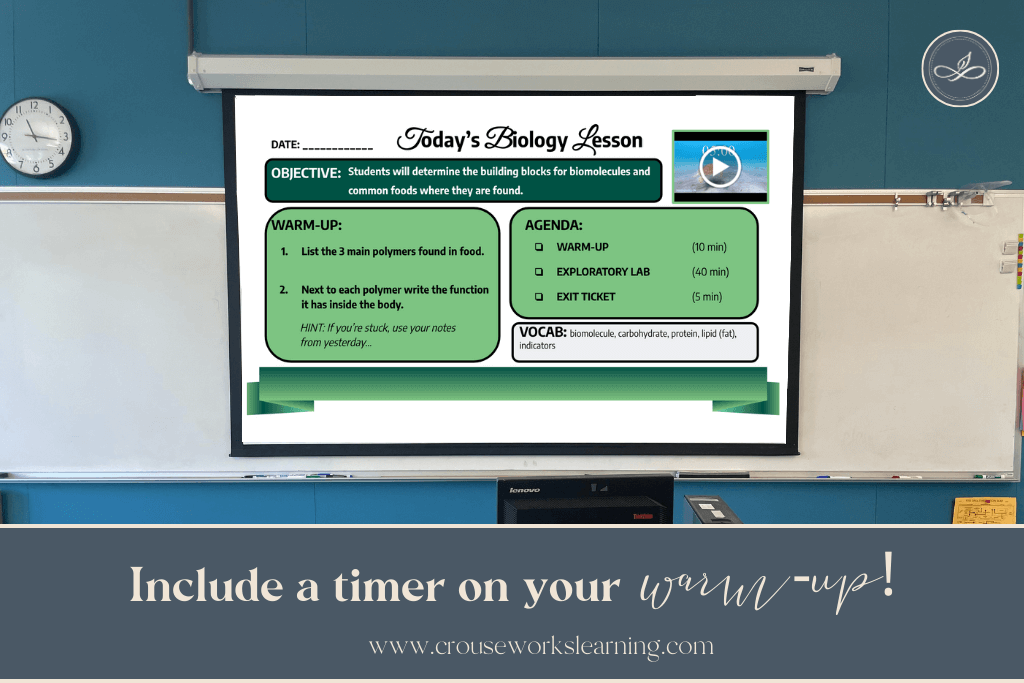
Therefore, as soon as students hear that song begin, they know that class has started.
And it is such a simple routine for me!
When the bell goes off, I turn off the lights (for calming purposes) and click play on that 5-min timer. And I am always amazed at how quickly students get started with class. I don’t even have to say a word! For teachers who especially hate getting on stage and gathering everyone’s attention to start the class, using a calming musical timer like this is a game-changer!
And because the music is so calming, I found that if students do finish before the 5 minutes is up, they just put their heads down and rest for a moment.
Now, quick disclaimer- for this trick to work, you have to play the same song every day and it needs to be a song that winds kids down (not winds them up).
FEATURE #3: Give immediate completion credit at the end of the warm-up
I don’t know about you, but I have always been amazed at the teachers that can quickly collect the warm-ups, spot-check them on the fly, and then develop a reteach or lesson pivot on the spot from the data they’ve analyzed. I cannot move that quickly.
Nor am I interested in collecting warm-ups on the spot and saving them to grade for later. That is not fun for me- not to mention you can sometimes lose momentum in your classroom because the “success” feeling that students get with the warm-up is removed or delayed.
So, my compromise over the years has been to walk around with a stamp after the 5 minutes is up and stamp any student’s warm-up sheet that is completed. It doesn’t matter if the answer is right or wrong. It doesn’t matter if they wrote run-on sentences to take up space. It doesn’t matter if they drew their responses instead of writing them. They just need to show me that they did some measurable work.
Now, if a kid wrote 3 words, that’s a different story. I usually tell that student, “If you want a stamp, I need to see more. I’ll come back in 2 min after I finish stamping everyone else. Better work quickly.” And that is usually enough to get kids going.

Then, once I’ve stamped everyone’s papers, which takes roughly 2-3 minutes, we’ll go over the answer as a class.
Stamping is helpful because students feel immediately accomplished and get a brief couple of seconds of 1-1 interaction with you. A smile, a “good to see you today,” or a “well done” really goes a long way at the beginning of class!
Another bonus trick. If I have a class that is usually pretty shy about participating in class discussions, I usually keep my eyes peeled for 1 or 2 great student answers while stamping the warm-ups. I’ll then ask those students if they would be okay sharing out their answers with the class when I get done stamping. Usually, the kids agree and are grateful to be acknowledged for their excellent work.
To wrap up...
So, back to the question we started with at the beginning of this post. If a first-year teacher asked you for your one piece of advice for setting up an effective classroom environment? What would you say? What would you consider to be the linchpin for setting your students up for success in the classroom?
For me, it’s always been creating a successful moment for students in the first 5 minutes of class. It builds confidence, momentum, and student buy-in. It’s a win-win for everyone, and I hope this post has given you some helpful strategies for structuring that kind of success at the beginning of your class.

P.S. If you’d like to see even MORE classroom management teacher hacks for the rest of your lesson, download my FREE “How to Manage Your Classroom Like a Boss” guidebook.
It’s an all-in-one guidebook that walks you through my best-kept strategies for getting students to start working at the bell, maintaining that momentum during class, and keeping your students working to the very last minute of class.
And the best news of all is it’s FREE! So download the guidebook now!
